This tiny-tailed squirrel has been hanging around our house for the past few months or so. He climbs trees, digs for nuts, and hops across the yard looking more like a small groundhog than he does a squirrel.
He does many of the activities other squirrels do, but does his lack of tail impair him at all? Doesn’t he need his tail to nail his landings when he leaps from branch to branch, kind of like a cheetah uses its tail to steer?
What happened to his tail, anyway? Did something attack him? Several years ago, we had another short-tailed squirrel we called Half-tail who had an odd white batch of fur on his side. Could this squirrel be Half-tail’s descendent? Is there a recessive gene that causes their tails to not grow to their full length?
What happened to this poor squirrel’s tail?
So, what do squirrels use their tails for, anyway? I did some quick research and found that squirrels use their tails to communicate with other squirrels. A swishy, slow whip-crack of tail movement while foraging is a warning to other squirrels to back off – these nuts are spoken for. But flicking the tail quickly while chirping and chattering is a warning to other squirrels about nearby predators.
The main predators of squirrels include coyotes, foxes, hawks, and of course humans. I also found that rat snakes and raccoons eat squirrels, but mainly just the babies from the nest. Weirdly, smallmouth and largemouth bass have also been found to eat squirrels. There are some gross videos online of fisherman gutting a fish to find a squirrel inside, and another cruel video of a man essentially feeding a baby squirrel to a hungry fish.
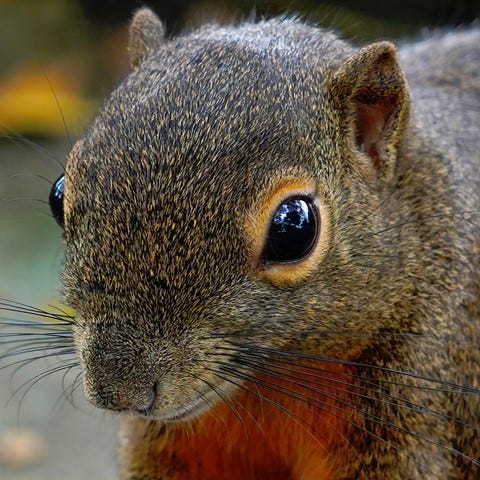
Squirrels have eyes on the sides of their heads (as most prey animals do) so they can have a wider field of vision to watch for predators sneaking up from behind. Another cool fact? They have yellow lenses on their eyes that act as sunglasses to reduce glare and protect them from UV radiation. Their eyes are also placed at a slightly upward angle that allows them to see incoming hawks swooping overhead. Just last week I saw a hawk fly just outside my car window with a tail dangling behind it – it had evidently just snagged a squirrel and was carting it off for dinner.

At our house, we have a very healthy red-tailed hawk population, so it’s possible they are our squirrels’ main predator. When squirrels sense a hawk overhead, they’ll flatten themselves against a tree trunk or try to quickly scoot to the far side of the tree trunk.
Some researchers believe squirrels also use their tail as a distractor to predators – swishing the tail back and forth could make the squirrel seem aggressive or the movement could be confusing.
But here’s where it gets weird – squirrels with short tails aren’t all that unusual because, like lizards, squirrels’ tails are designed to break off!
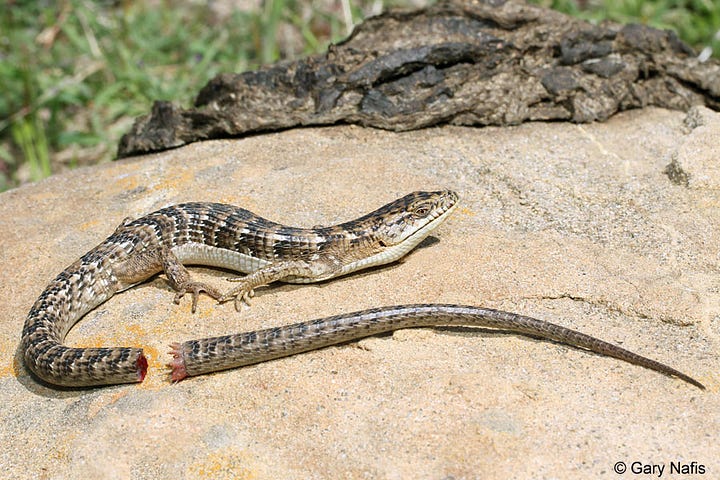
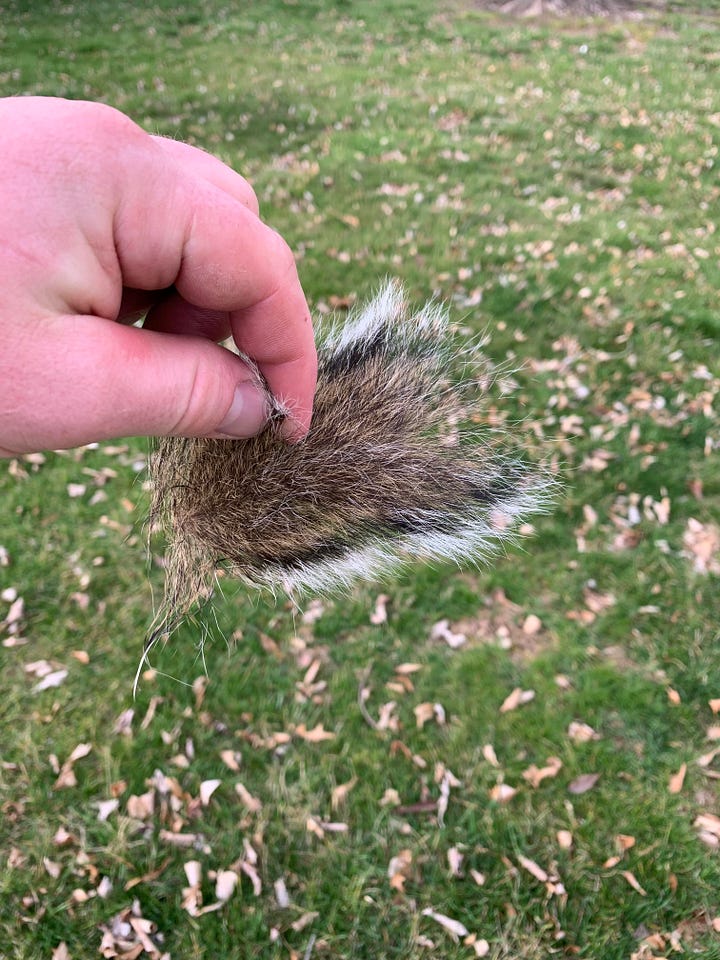
Just like with lizards, if a predator grabs a squirrel by its tail, the tail breaks and allows the victim to run away, leaving the hawk (or coyote or fox) with a fragment of tail and nothing else. However, unlike lizards, squirrels tails will never grow back. I’ve seen bits of squirrel tails in the woods before, but I had no idea it was evidence of a narrow escape from death…
So, our little guy with the tiny tail was probably attacked by a predator at some point, a predator left with a fairly long piece of squirrel tail while Stubby ran off with his life.
If you look closely at the photo above, you’ll notice some large round growths on the side of the squirrel. These are called “warbles” or “wolves” and are (get ready…) botfly larvae growing under its skin. Botflies lay their eggs on twigs and branches where squirrels and other rodents travel. Squirrels brush up against the eggs and pick them up on their fur, and when the eggs hatch, they crawl into the squirrel’s mouth, nose, or other opening. The larvae spend a week or so touring the inside of the squirrel before finding a spot to hang out just under its skin. They poke a small hole in the side of the squirrel for air to come in and waste to go out, and spend the next month munching away on the squirrel’s insides before finally crawling out the hole.
Despite all that grossness, wolves are not harmful to the squirrel – they’re just another parasite, similar to fleas and ticks, that make their way in the world by latching onto other creatures.
As for little Stubby, along with his loss of communication via his tail, he’s also lost some of his hyperactive mobility since squirrels typically use their tails as rudders during jumps to help them steer and land safely. They also can use the tail as a sort of parachute, slowing their fall up to 60 feet without injuring themselves.
That may explain why we’ve seen Stubby so often – he may not spend as much time high in the treetops as other squirrels. Or perhaps he does, and he’s just more conservative in his leaps from branch to branch. Either way, if he could talk he’d have at least one really good story to tell!

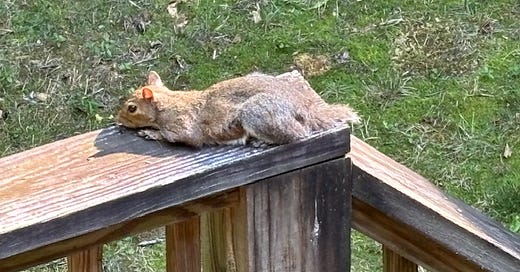



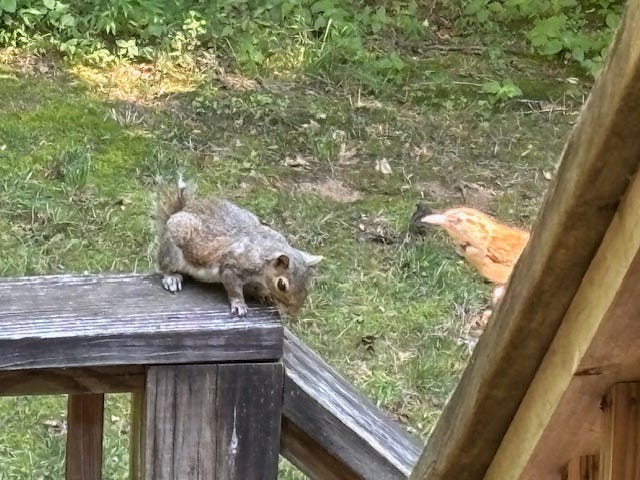
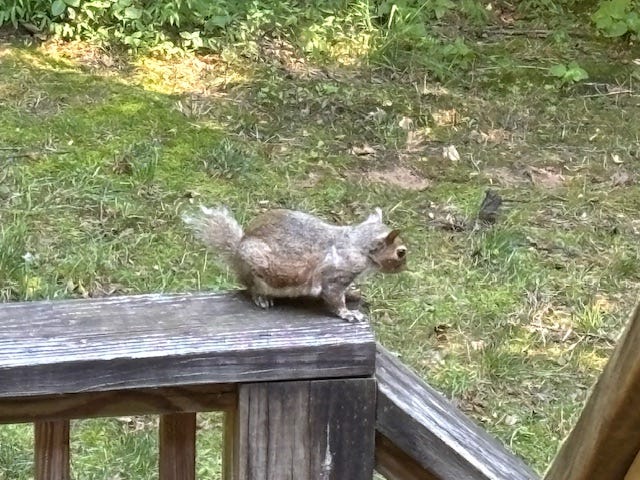

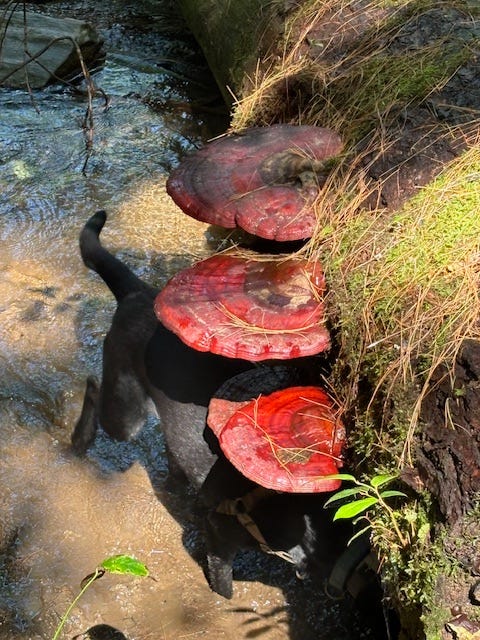
The fungus is probably a species of Ganoderma (perhaps lucidum), a root-rot fungus. Here is a Wikipedia link: https://en.wikipedia.org/wiki/Ganoderma.
You forgot a squirrel cause of sudden death, Heather! Electricution! Junction boxes are on top of poles in our tree-ey neighbohood. Squirrels would clamber from tree to power line, tightrope walk along same, reach pole too and box and bzzzt⚡ Squirrels would fall to ground, everyone's power would go out, the PGE power company's cherry picker would arrive, guy in bucket goes up and does something, lights go back on and we all have to reset all our digital clocks!